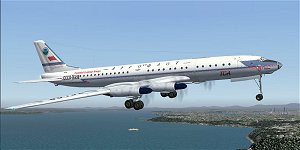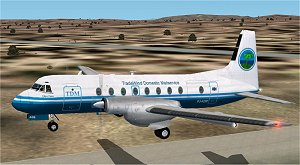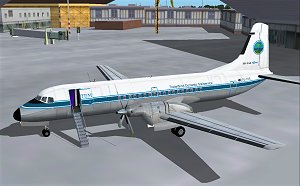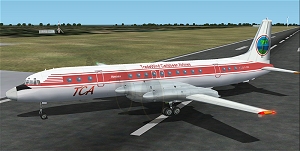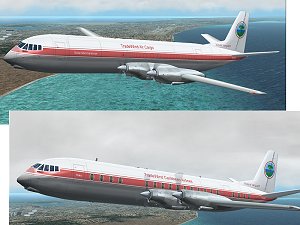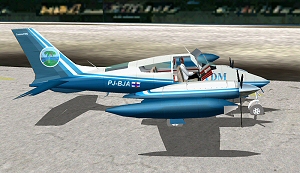|
FS2002 Vickers Viscount 800 PJ-VVB 'Providenciales' in 1950s scheme
The Vickers Viscount was the first turboprop airliner to enter service
anywhere in the world, the prototype flying on July 16, 1948. Certification
was achieved on April 17, 1953, and it entered service with BEA the next
day. Whilst Australian National Airlines intended to stick with piston
engined aircraft such as the DC-6, TAA (Trans-Australia Airlines) ordered
six Viscounts, the first arriving in October 1954 - registered as VH-TAA
and named John Batman. Planned commencement of service on December 1 was
deferred when the aircraft crashed on a training flight, killing three
of the five people on board, on 30th October 1954.
TAA's next Viscount, VH-TVB Gregory Blaxland made a 3-hour demonstration
flight between Melbourne, Vic. and Brisbane, Qld. on December 13th, and
regular services began five days later. TAA also fitted a Viscount with
slipper fuel tanks to equip it for the long flight Melbourne-Adelaide-Perth.
Following this competitive move, TAA ordered more Viscounts, and ANA tentatively
ordered more DC-6Bs. Ansett applied to purchase a further Convair 340.
By 1957, TAA's Viscount fleet numbered twelve, including three with the
additional fuel tanks and two with the Mk. 506 Dart engines which added
30 kts. (56 km./hr.) to their speed.
Butler Air Transport also ordered Viscounts, and found the runways which
had served their DC-3 fleet were too short for the new aircraft. They
broke into the Melbourne-Sydney route with Viscount VH-BAT Warral on 12
December, 1955. The Department of Civil Aviation, meanwhile, declared
several provincial airports unsuitable for Viscount operations. Butler
acquired three Airspeed Ambassadors in 1957 to keep up services to these
airports which their DC-3s could no longer handle.
As TAA Continued to expand its fleet during 1957-58, Ansett gained control
of both ANA and Butler. As competition progressed, Ansett-ANA purchased
L.188 Electras, Friendships and Viscounts. With the advent of the Boeing
727 and DC-9 jet airliners, the Viscount era ended, the remaining Viscounts
being withdrawn from service during 1969-71. The V.810 series aircraft
were generally sold overseas, except for a sole example, VH-TVR, at Moorabbin
Air Museum. The surviving V.700 Viscounts were scrapped, except for one
sold to an African buyer. By 1998, only about ten Viscounts were still
flying, all in Africa.
The RAAF operated two Viscounts (A6-435 and A6-436) from late 1964 until
March 1969. They served as VIP transports with 34 Sqn., alongside Convair
440s and Dakotas, and ended their service with less than 5000 hours on
their airframes (including pre-RAAF time) when they were replaced by the
BAC One Eleven.
Vickers Viscount 800
In 1952 Vickers proposed an enlarged version of the Viscount, designed
around the up-rated 1,690-ehp. Dart R.Da.5. The “stretch” in
this version was primarily in payload. By lengthening the fuselage by
13 ft. 3 in. It was possible to provide for as many as eighty six passengers.
At a gross weight of 65,000 lb. this version –called the V800 Series-had
a cruising speed a little below 300 mph. , whereas the V700D Series cruised
at 326 mph and the original V700 figure was 300 mph.
On February 11 1953, BEA placed an order for twelve o the enlarged Viscounts,
which took the customer designation V801. Further consideration of the
project, however, by both Vickers and BEA, led to the conclusion that
the “stretch” was too great.
In the course of the next year, the V800 Series was redesigned, therefore,
around the still more powerful 1,740-ehp Dart R.Da.6, which was already
being used in the V700D. The fuselage length was reconsidered and a figure
of 3 ft. 10 in. was eventually accepted, although the effective cabin
length was increased by 9 ft. 3 in. by relocating the rear pressure bulkhead
further aft.
Thus redesigned, the new Viscount seated sixty five passengers and with
a gross weight of 63,000 lb. it cruised at 320 mph. BEA changed its order
to the new variant on April 14th 1954, taking up an option on ten more
a year later. The designation for BEA changed to V802 and apart from the
longer fuselage, a distinguishing feature was the use of rectangular rather
than elliptical main cabin doors.
The V800 Series Viscount was further developed into the V810, which
had a strengthened airframe for 2,100-ehp Dart R.Da.7. (mk 525) engines,
gross weight increased to 69,000 lb and higher cruising speeds. After
going into service, the V810 was cleared for operation at weights up to
72,000 lb., or more than double the weight of the of the original VC 2
project. FAA approval for operations in the USA was obtained on April
22nd 1958.
from Turbine Engined Airliners of the World by F.G.Swanborough.
|

|

